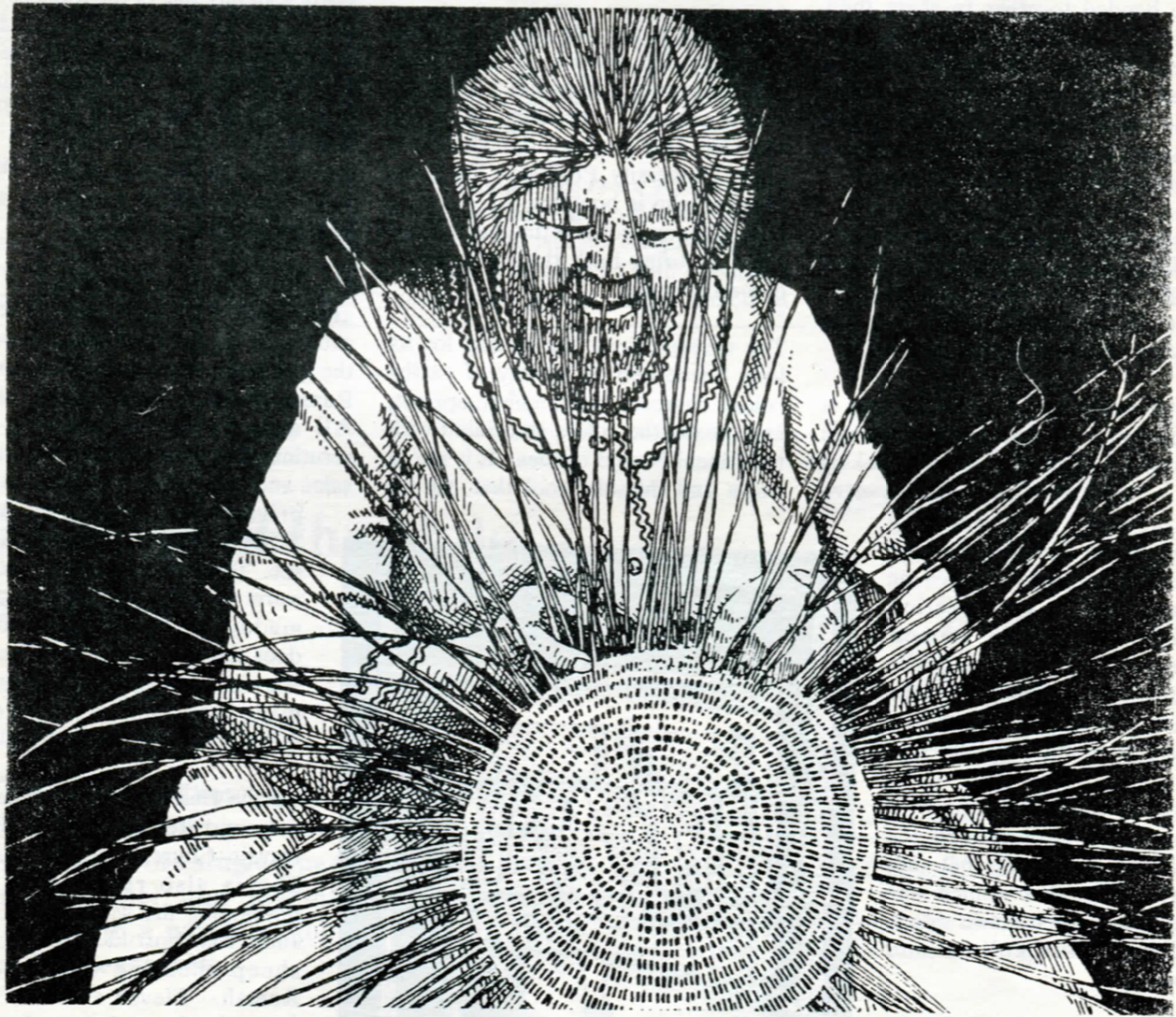
Navajo Women Unite Tradition and Economy
by Peggy Berryhill
Nestled among pine covered valley floors, with red rock mesas dotting the horizon, sit Navajo weavers. Like their grandmothers before them they are seated below upright looms, their nimble fingers carefully weaving blankets and rugs for home, decorative or ceremonial use. The looms they use and the drop spindle method of spinning yarn is unchanged, a tried and true method adopted from their Pueblo neighbors hundreds of years earlier; but the art of weaving beautifully designed textiles is now distinctly Navajo.
The weaving tradition involves a lifestyle based on sheep and wool production which the Ramah Weavers Association is developing as an economic base for self-sufficiency. Throughout history artist associations have banded together to share their skills and market their wares. The Ramah Weavers Association is such a group. Founded in November of 1984 these Navajo women are striving to preserve their cultural art form and achieve a better standard of living.
"We're looking to improve the weavers' quality of life, not necessarily linked to (cash) income. The main thing is increased self-sufficiency," says Yin May Lee, Planner for the association.
Three years ago when Lee was a community planner for the Ramah Navajo School Board she was looking for a project that would involve grassroots community development and women. After talking to weavers in the area the concept of an organization which would help women increase their income while preserving tradition became the foundation upon which the organization was formed.
About 40 women spanning three generations have formed the group which involves not only weavers but other women who are learning the business side in order to unite culture and economy.
The Ramah community is an isolated rural community in the Navajo reservation, comprising approximately 287,000 acres with a population of 2,000. The average per capita income is $2,000 a year and two thirds of the population receives some form of public assistance.
The Navajo Reservation is dotted with weaving communities: The 80 - 100 weavers of Ramah are not as well known as other regional weavers. But they are accomplished weavers who lend their own unique interpretations to traditional designs.
Innovation is the key to a successful future for the women. Part of their self-sufficiency plan includes a Navajo sheep project to produce wool for weaving. This project originated with Utah University Professor Dr. Lyle McNeal who is breeding the old type Navajo sheep known as the churro in an effort to bring back this endangered domestic animal.
The weavers favor the churro for its long fleece and its variety of earthy colors: charcoal, burnt amber, apricot, and cream, the colors associated with traditional Navajo textiles. It is also a warm and durable wool that can be handspun into a strong, thin yarn suitable for the finest weave. The wool is gaining popularity among the non-native weavers as well.
"We've been weaving our dreams," says Nada Rafelito, one of the trainees with the association. She is learning marketing skills and deals with the day to day business of filling orders, inventory and rug buying days. Each month the association holds a rug buying day in Ramah. Local public radio station KTDB announces sales and association meetings.
Quality control is a concern of the group and they have established a standards committee that reviews all the rugs before they are sold under the Ramah Weavers Association's name. All aspects of the weaving are scrutinized by the committee before the sales and individual members receive private critiquing. Says May, "They look for the things you don't see. They check the wool and the warp. Are the dyes clear and not muddy; are the edges straight, does the rug have good corners? We continually improve the work, make people more aware of factors that affect the saleability."
Cecilia Ensrude, another trainee, helps monitor the progress of the Navajo-Churro breeding project. She is also responsible for developing the wool market. In June, Ms. Ensrude organized a sheep shearing workshop in Ramah. Eleven students paid $75.00 for the week-long class and local herders brought 400 sheep to be sheared. Learning how to shear and grade wool will help herders earn more money from their flocks. Murray Christie, an expert sheep shearer and grader from New Zealand, taught the class.
The association is attracting attention from foundations who work see their venture as a viable economic alternative for women in rural communities.
Ms. Lee is pleased that the hinders have been attracted to this project. Lee says, "It is the first of its kind on the reservation. They took a chance on a project like this, to let it evolve, it's a risk." First Nations Financial Project, the Seventh Generation Fund and Ms. Foundation are among their supporters.
Laurie Fourier of First Nations Financial Project is doing marketing research on a national basis for the Ramah Weavers Association. She sees their keen interest in marketing as a plus.
"I think Ramah is going to be one of the more successful groups. They're looking at all areas," she says. "I'm really impressed by the way they handle themselves. Because they are not running into it, they are talking from their own needs. They know what they want rather than someone telling them what they need."
The Ramah Weavers Association incorporates the traditional family values of the Navajo, the preservation of a life-style coupled with grassroots community development aimed at securing a stable economic future for women who choose to practice weaving as did their mothers before.
They are weaving a message that is clear. Economic security and traditions can be combined.
Source:
Native Self-Sufficiency Published by Seventh Generation Fund for Indian Development P.O. Box Forestville, CA 95436, USA

